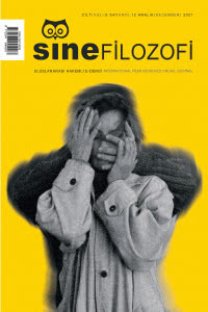Posthuman Subjectivity and Implied Dreams in Animation Cinema
Subjectivity, difference, becoming
Posthuman Subjectivity and Implied Dreams in Animation Cinema
Subject, difference, becoming.,
___
- Akyol Oktan, K. (2019). Tekillik, İnsan-Sonrası (Post-Human) ve Göçebe Cinsiyetler. E. Baştürk ve B. N. Erdem (Ed.). Dijital Medya ve Toplumsal Cinsiyet- Kavramlar Fırsatlar Sınırlılıklar, 283-318. Konya: Litera-Türk.
- Akyol Oktan, K. & Oktan, A. (2019). Digital Immortality: Transhumanism in the Case of “Altered Carbon”. New Approaches in Media and Communication, 275.
- Bigelow, S. J. (2009). Technologies Of Perception: Miyazaki in Theory and Practice. Animation, 4(1), 55-75.
- Boyd, J. W. & Nishimura, T. (2004). Shinto Perspectives in Miyazaki's Anime Film "Spirited Away". Journal of Religion & Film, 8(3), 4.
- Braidotti, R. (2013). The Posthuman. Cambridge: Polity.
- Braidotti, R. (2019). İnsan Sonrası, Pek İnsanca: Bir Posthümanistin Anıları ve Emelleri, Cogito, 95(96), 53-97.
- Çubuklu, Y. (2004). Toplumsalın Sınırında Beden. İstanbul: Kanat.
- Deleuze, G. (1990). The Logic of Sense. Constantin V. Boundas (ed.), Mark Lester (Trans.) London: The Athlone.
- Deleuze, G. (2004). Desert Islands and Other Texts 1953-1974. David Lapoujade (Ed.), Michael Taormina (Trans.), Los Angeles: Semiotext(e).
- Deleuze, G. (1995). Negotiations. Martin Joughin (Trans.), New York: Columbia University.
- Deleuze, G. & Parnet, C. (2007). Dialogues II, Hugh Tomlinson And Barbara Habberjam (trans.), New York: Columbia University.
- Dempsey, R. (Producer) & Miyazaki, H. (Director). (2004). Howl’s Moving Castle [Motion Picture]. Japan: Studio Ghibli.
- Dreyfus H. L. & Wrathall, M. A., (2006). A Brief Introduction to Phenomenology and Existentialism, Dreyfus H. L., Wrathall M. A (Ed.), Companion to Phenomenology and Existentialism, Malden: Blackwell.
- Duman, Fatih, (2010). Aydınlanma Eleştirisinden Devrim Karşıtlığına: Edmund Burke, Ankara: Liberte.
- Erdoğan Tuğran, F. (2016). Türk Sineması’nda Fantastiğin Dönüşümü: Deleuzeyen Bir Yaklaşım. (Unpublished doctorate thesis). İstanbul Üniversitesi/Sosyal Bilimler Enstitüsü, İstanbul.
- Foucault, M. (1997). Of Other Spaces: Utopias and Heterotopias. Rethinking Architecture: A Reader İn Cultural Theory, 350-356, Neil Leach (Ed.), London, New York: Routledge.
- Guattari, F. (2016). Lines of Flight: For Another World of Possibilities. Andrew Goffey (Trans.), London: Bloomsbury Academic.
- Haraway, D. J. (2008). When Species Meet, London: the University of Minnesota.
- Haraway, D. J. (2016). A Cyborg Manifesto: Science, Technology, And Socialist–Feminism in The Late Twentieth Century. Minnesota: University of Minnesota. E kitap
- Hardt, M. & Negry, A. (2001). Empire. Cambridge: Harvard University.
- Kara, Z. (2015). Sosyolojinin Deleuze’dan Anladığı: Arzu Makinasından Organsız Bedenlere. Sosyoloji Divanı, (4).
- Kılıç, S. (2012). Deleuze-Guattari: Yersizyurtsuzlaştırma Makinesi Olarak Şizoanalitik Fark ve Arzu Ontolojisi. (Unpublished doctorate thesis). Uludağ Üniversitesi/Sosyal Bilimler Enstitüsü, Bursa.
- Laclau, E. (2001). Can Immanence Explain Social Struggles?. The Johns Hopkins University, 31/4: 2-10.
- Lloyd, G. (1996). Erkek Akıl. Muttalip Özcan (Çev.), İstanbul: Ayrıntı.
- Mayumi, K., Solomon, B.D. & Chang, J. (2005).The Ecological and Consumption Themes of The Films of Hayao Miyazaki. Ecological Economics, 54 (1), 1-7.
- Nietzsche, F. W. (2009). On the Genealogy of Morals: A Polemical Tract. Ian Johnston (Trans.), Virginia: Richer Resources.
- Nietzsche, F. W. (2007). Beyond Good and Evil: Prelude to a Philosophy of the Future. Rolf-Peter Horstmann and Judith Norman (Ed.), Judith Norman (Trans.), Cambridge: Cambridge University.
- Özlem, D. (1998). “Giriş: Heidegger ve Teknik”, Tekniğe İlişkin Soruşturma, Martin Heidegger, İstanbul: Paradigma.
- Öztürk, S. (2018). Sinema Felsefesine Giriş: Film-Yapımı Felsefe. Ankara: Ütopya.
- Rockmore, T. (2009). Heidegger'in Nazizmi, Kant ve Dasein Üzerine. Felsefe Yazın, 15: 25-31.
- Roth, J., Todd, S., Todd, J., Burton, T. (Producer), & Bobin, J. (Director). (2016). Alice Through the Looking Glass [Motion Picture]. United States: Walt Disney Pictures.
- Saygılı, A. (2005). Modern Devletin Beden İdeolojisi Üzerine Kısa Bir Deneme. Ankara Üniversitesi Hukuk Fakültesi Dergisi, 54(3), 323-340.
- Suzuki, T. (Producer), & Miyazaki, H. (Director). (1997). Princess Mononke [Motion Picture]. Japan: Studio Ghibli.
- Van Der Zaag, A. C. (2016). On Posthuman Subjectivity. Journal of Cultural Economy, 9(3), 330-336.
- Yıldız, N. (2018). Nietzsche’de Arı Öznenin Eleştirisi. Kilikya Felsefe Dergisi, 1(90), 103.
- Zanuck, R. D., Roth, J., Todd, S., Todd, J., (Producer), & Burton, T. (Director). (2010). Alice in Wonderland [Motion Picture]. United States: Walt Disney Pictures.
- Yayın Aralığı: 2
- Başlangıç: 2016
- Yayıncı: Serdar Öztürk
Amerikan Deneysel Sineması ve Yeraltı ‘’Underground’’ Sinema Kültüründe Andy Warhol’un Film Yapısı
Performatif Bir Araştırma Olarak Video Denemeleri Yeni Bir Kavram ile Düşünmek: Transimaj
Yeni Aşırılığın Auteur Yönetmeni Bir L’enfant Terrible Olarak Gaspar Noé
Hegel'de Bilinç ve Özgürlük İlişkisi Bağlamında Karakter FilmiÜzerineBirİnceleme
Film ve Rüya Deneyimi İlişkisi Üzerine Bir Okuma Denemesi: Gizli Yüz
Tony Gatlif’in Aksanlı Sinemasına Deleuzyen Bir Bakış
Ahmet Oktan, Almıla Nur Berilğen
Kurtuluş ÖZGEN, Işkın ÖZBULDUK KILIÇ
